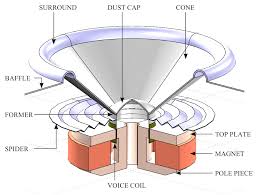Loudspeaker is an electroacoustic transducer, that is, a device that converts an electrical audio signal into a corresponding sound. A speaker system, also often simply referred to as a “speaker” or “loudspeaker”, comprises one or more. Such speaker drivers (above definition), an enclosure, and electrical connections possibly including a crossover network. The speaker driver can be viewed as a linear motor attached to a diaphragm. Which couples that motor’s movement to motion of air, that is, sound.
An audio signal, typically from a microphone, recording, or radio broadcast. It is amplified electronically to a power level capable of driving. That motor in order to reproduce the sound corresponding to the original unamplified electronic signal. This is thus the opposite function to the microphone. And indeed the dynamic speaker driver, by far the most common type. It is a linear motor in the same basic configuration as the dynamic microphone. Which uses such a motor in reverse, as a generator.
Is loudspeaker A amplifier?
Speakers make sound, amps make speakers sound. Obviously a loudspeaker is very different than a power amplifier. A loudspeaker is mechanical in nature; it has electrical properties that animate its mechanics. A power amplifier is electrical; we cannot hear or see what goes in or out.
What is inside a speaker?
Also known as the “tweeter”, “woofer” & “mid-range”, every speaker uses a different configuration of drivers. Whether a woofer or a tweeter, all drivers comprise of an electromagnetic voice coil, a stationary magnet and a diaphragm. The coil needs to be free to move in and out of the magnet gap, but not side to side.
What is the purpose of an amp for speakers?
An amplifier is the device that turns the low voltage signals from your source equipment into a signal with enough gain to be used to power a pair of speakers.
Is 100W RMS loud?
There are many factors how loud a speaker can play while consuming 100W RMS. First factor is speaker sensitivity. Say one speaker is 88dB and another is 98dB per RMS watt at 1m . For 100W RMS consumption, first speaker will play 108 dB and second speaker will play 118dB.
Can you hear music coming out from the speaker?
Except for earphones, loudspeakers are usually some distance from our ears. The sound waves produced by the speaker cones have to travel through the air in a room before we can hear them. But sound waves travel out from speakers in all directions.
How do I make my speakers louder?
In general, people can plug multiple speakers in the same room and that will generate more sound, of course. However, another way to make the sound amplify louder is to set the speaker in a corner or close to the corner. This can actually amplify the volume by 40 percent in the room.
How can I make my speakers sound better?
- Position the speaker pair as far from one another as they are from the primary seating position.
- Move them in from the back wall roughly 18 inches, if the room allows it.
- Toe each speaker inward slightly.
- Turn the volume down to a level where the speakers do not sound distressed.
How do I get my speakers to work?
Speakers work by converting electrical energy into mechanical energy (motion). The mechanical energy compresses air and converts the motion into sound energy or sound pressure level (SPL). When an electric current is sent through a coil of wire, it induces a magnetic field.
Why do speakers have magnets?
To make the cone (or panel) of the speaker move, magnets are used to create an opposing magnetic field which creates vibrations. These vibrations are the sound we hear. Speakers often contain large magnets inside of them, as a larger opposing magnetic field creates more vibrations.





